Paper Menu >>
Journal Menu >>
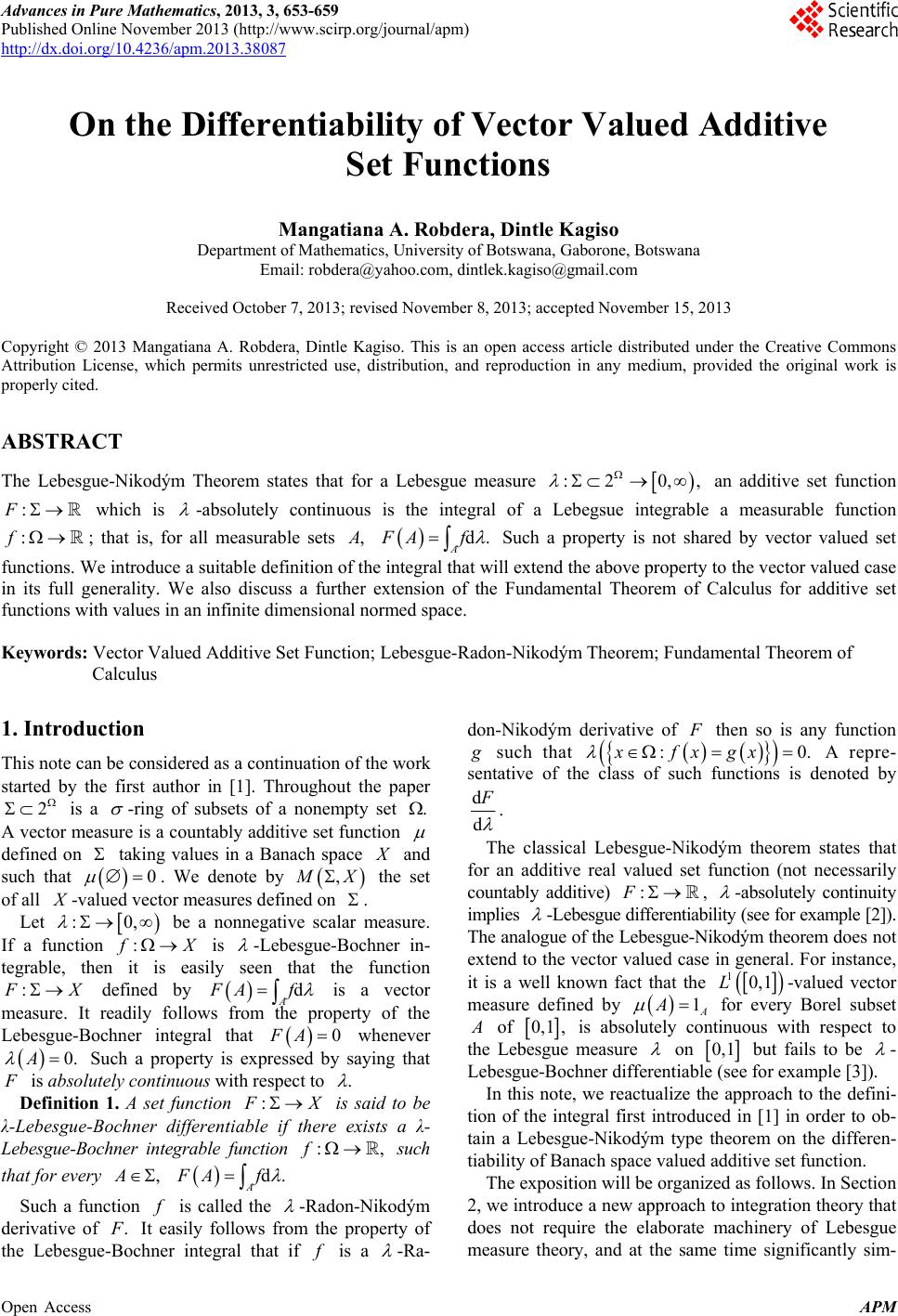 Advances in Pure Mathematics, 2013, 3, 653-659 Published Online November 2013 (http://www.scirp.org/journal/apm) http://dx.doi.org/10.4236/apm.2013.38087 Open Access APM On the Differentiability of Vector Valued Additive Set Functions Mangatiana A. Robdera, Dintle Kagiso Department of Mathematics, University of Botswana, Gaborone, Botswana Email: robdera@yahoo.com, dintlek.kagiso@gmail.com Received October 7, 2013; revised November 8, 2013; accepted November 15, 2013 Copyright © 2013 Mangatiana A. Robdera, Dintle Kagiso. This is an open access article distributed under the Creative Commons Attribution License, which permits unrestricted use, distribution, and reproduction in any medium, provided the original work is properly cited. ABSTRACT The Lebesgue-Nikodým Theorem states that for a Lebesgue measure :2 0, , an additive set function which is :F -absolutely continuous is the integral of a Lebegsue integrable a measurable function ; that is, for all measurable sets :f, A d. A F Af Such a property is not shared by vector valued set functions. We introduce a suitable definition of the integral that will extend the above property to the vector valued case in its full generality. We also discuss a further extension of the Fundamental Theorem of Calculus for additive set functions with values in an infinite dimensional normed space. Keywords: Vector Valued Additive Set Function; Lebesgue-Radon-Nikodým Theorem; Fundamental Theorem of Calculus 1. Introduction This note can be considered as a continuation of the work started by the first author in [1]. Throughout the paper is a 2 -ring of subsets of a nonempty set . A vector measure is a countably additive set function defined on taking values in a Banach space X and such that . We denote by 0 , M X the set of all X -valued vector measures defined on . Let be a nonnegative scalar measure. If a function :0, : f X is -Lebesgue-Bochner in- tegrable, then it is easily seen that the function : F X defined by d A F Af FA is a vector measure. It readily follows from the property of the Lebesgue-Bochner integral that whenever Such a property is expressed by saying that 0 A 0. F is absolutely continuous with respect to . Definition 1. A set function : F X f is said to be λ-Lebesgue-Bochner differentiable if there exists a λ- Lebesgue-Bochner integrable function such :, that for every ,A d. A F Af Such a function f is called the -Radon-Nikodým derivative of . F It easily follows from the property of the Lebesgue-Bochner integral that if f is a -Ra- don-Nikodým derivative of F then so is any function g such that :0xfxgx . A repre- sentative of the class of such functions is denoted by d d F . The classical Lebesgue-Nikodým theorem states that for an additive real valued set function (not necessarily countably additive) :F , -absolutely continuity implies -Lebesgue differentiability (see for example [2]). The analogue of the Lebesgue-Nikodým theorem does not extend to the vector valued case in general. For instance, it is a well known fact that the 10,1L-valued vector measure defined by A 1A for every Borel subset A of 0,1, is absolutely continuous with respect to the Lebesgue measure on 0,1 but fails to be - Lebesgue-Bochner differentiable (see for example [3]). In this note, we reactualize the approach to the defini- tion of the integral first introduced in [1] in order to ob- tain a Lebesgue-Nikodým type theorem on the differen- tiability of Banach space valued additive set function. The exposition will be organized as follows. In Section 2, we introduce a new approach to integration theory that does not require the elaborate machinery of Lebesgue measure theory, and at the same time significantly sim- 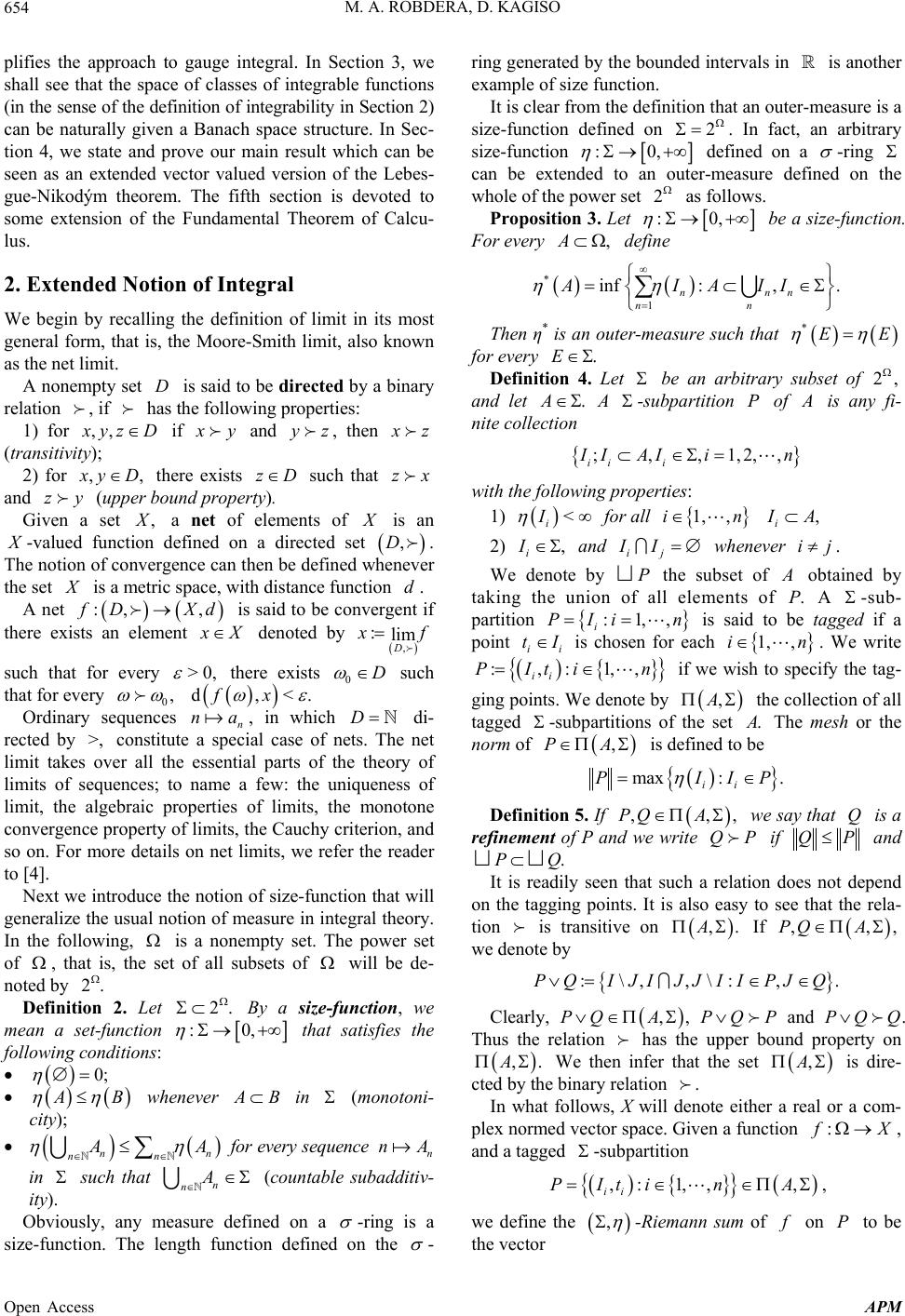 M. A. ROBDERA, D. KAGISO 654 plifies the approach to gauge integral. In Section 3, we shall see that the space of classes of integrable functions (in the sense of the definition of integrability in Section 2) can be naturally given a Banach space structure. In Sec- tion 4, we state and prove our main result which can be seen as an extended vector valued version of the Lebes- gue-Nikodým theorem. The fifth section is devoted to some extension of the Fundamental Theorem of Calcu- lus. 2. Extended Notion of Integral We begin by recalling the definition of limit in its most general form, that is, the Moore-Smith limit, also known as the net limit. A nonempty set is said to be directed by a binary relation , if has the following properties: D 1) for ,, x yz D if x y and , then yz x z (transitivity); 2) for ,, x yD y there exists such that and ( upper bound property). zDzx z Given a set , X a net of elements of X is an X -valued function defined on a directed set ,D. The notion of convergence can then be defined whenever the set X is a metric space, with distance function . d A net :, , f DXd is said to be convergent if there exists an element x X denoted by , :lim D x f such that for every >0, there exists 0D such that for every 0, d,<fx. a Ordinary sequences n, in which nD di- rected by constitute a special case of nets. The net limit takes over all the essential parts of the theory of limits of sequences; to name a few: the uniqueness of limit, the algebraic properties of limits, the monotone convergence property of limits, the Cauchy criterion, and so on. For more details on net limits, we refer the reader to [4]. >, Next we introduce the notion of size-function that will generalize the usual notion of measure in integral theory. In the following, is a nonempty set. The power set of , that is, the set of all subsets of will be de- noted by 2. Definition 2. Let By a size-function, we mean a set-function 2. : 0, that satisfies the following conditions: 0; A B whenever A B in (monotoni- city); n n n n A A for every sequence n nA in such that (countable subadditiv- ity). n nA Obviously, any measure defined on a -ring is a size-function. The length function defined on the - ring generated by the bounded intervals in is another example of size function. It is clear from the definition that an outer-measure is a size-function defined on 2 . In fact, an arbitrary size-function : 0, defined on a -ring can be extended to an outer-measure defined on the whole of the power set 2 as follows. Proposition 3. Let :0, be a size-function. For every define ,A * 1 inf:, . n n nn AIAI n I Then η* is an outer-measure such that EE * for every .E Definition 4. Let be an arbitrary subset of 2, and let .A A -subpartition of P A is any fi- nite collection ,;,,1,2, ii i I IAI in with the following properties: 1) < i I for all 1, ,in , i I A 2) , i I and ij II whenever . ij We denote by the subset of P A obtained by taking the union of all elements of A .P -sub- partition , i PI n ii I :1,i is said to be tagge d if a point t is chosen for each . We write , n1,i ::, 1,, ii P It in if we wish to specify the tag- ging points. We denote by ,A the collection of all tagged -subpartitions of the set . A The mesh or the norm of ,PA is defined to be max :. ii P IIP Definition 5. If ,,PQA , Q we say that Q is a refinement of P and we write if PQP and .PQ It is readily seen that such a relation does not depend on the tagging points. It is also easy to see that the rela- tion is transitive on ,.A If ,,PQ A , we denote by :\, ,\:,PQIJIJJII PJ Q . Clearly, ,PQ A , and PQ. Thus the relation has the upper bound property on PQ PQ ,.A We then infer that the set is dire- cted by the binary relation . ,A In what follows, X will denote either a real or a com- plex normed vector space. Given a function : f X , and a tagged -subpartition ,: 1,,, ii PItin A , we define the , -Riemann sum of f on to be the vector P Open Access APM 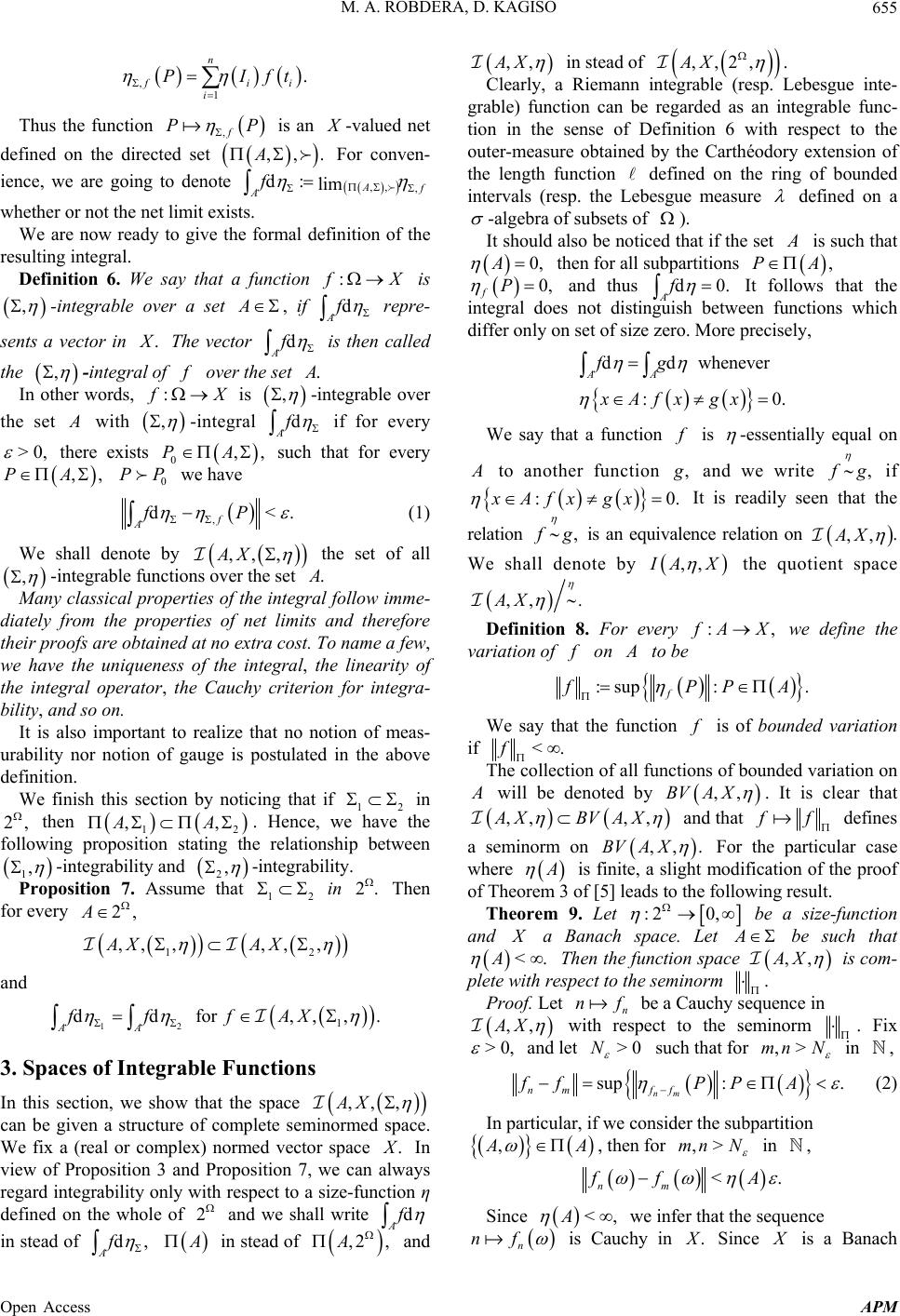 M. A. ROBDERA, D. KAGISO 655 , 1 . n fi i PIf i t P Thus the function is an ,f P X -valued net defined on the directed set ,,A d: li . For conven- ience, we are going to denote ,, , mA f Af whether or not the net limit exists. We are now ready to give the formal definition of the resulting integral. Definition 6. We say that a function : f X is , -integrable over a set A , if d Af repre- sents a vector in . X The vector d Af is then called the , -integral of f over the set . A In other words, : f X is , -integrable over the set A with , -integral df A if for every >0, there exists such that for every 0,PA , ,,PA we have 0 PP , d< f AfP. (1) We shall denote by ,,,AX the set of all , -integrable functions over the set . A Many classical properties of the integral follow imme- diately from the properties of net limits and therefore their proofs are obtained at no extra cost. To name a few, we have the uniqueness of the integral, the linearity of the integral operator, the Cauchy criterion for integra- bility, and so on. It is also important to realize that no notion of meas- urability nor notion of gauge is postulated in the above definition. We finish this section by noticing that if 12 in then 2, 1 ,AA 2 . Hence, we have the following proposition stating the relationship between , 1, -integrability and 2, -integrability. Proposition 7. Assume that in 1 22. Then for every 2,A 12 ,, ,,,,AX AX and 12 1 dd for ,,, AA ff fAX. 3. Spaces of Integrable Functions In this section, we show that the space ,, ,AX . can be given a structure of complete seminormed space. We fix a (real or complex) normed vector space X In view of Proposition 3 and Proposition 7, we can always regard integrability only with respect to a size-function η defined on the whole of and we shall write 2d A f in stead of d, Af A in stead of and ,2 ,A ,,AX in stead of ,,2,AX . Clearly, a Riemann integrable (resp. Lebesgue inte- grable) function can be regarded as an integrable func- tion in the sense of Definition 6 with respect to the outer-measure obtained by the Carthéodory extension of the length function defined on the ring of bounded intervals (resp. the Lebesgue measure defined on a -algebra of subsets of ). It should also be noticed that if the set A is such that 0,A then for all subpartitions ,PA 0, fP and thus A It follows that the integral does not distinguish between functions which differ only on set of size zero. More precisely, d0f . . dd whenever :0 AA fg xAfx gx We say that a function f is -essentially equal on A to another function , g and we write , f g if :xAfxgx 0. It is readily seen that the relation , f g is an equivalence relation on ,,AX . We shall denote by ,, I AX the quotient space ,, .AX Definition 8. For every :, f AX we define the variation of f on A to be :sup :. f f PP A We say that the function f is of bounded variation if <.f The collection of all functions of bounded variation on A will be denoted by ,,BVA X . It is clear that ,, ,,AXBVAX and that f f defines a seminorm on ,, .BVA X For the particular case where A is finite, a slight modification of the proof of Theorem 3 of [5] leads to the following result. Theorem 9. Let :2 0, be a size-function and X a Banach space. Let A be such that <.A Then the function space ,,AX is com- plete with respect to the seminorm . Proof. Let n be a Cauchy sequence in nf ,,AX with respect to the seminorm . Fix >0, and let such that for >0N ,>mnN in , sup :. nm nm ff ffPP A (2) In particular, if we consider the subpartition , A A , then for ,>mnN in , <. nm ff A Since <,A we infer that the sequence n nf is Cauchy in . X Since X is a Banach Open Access APM 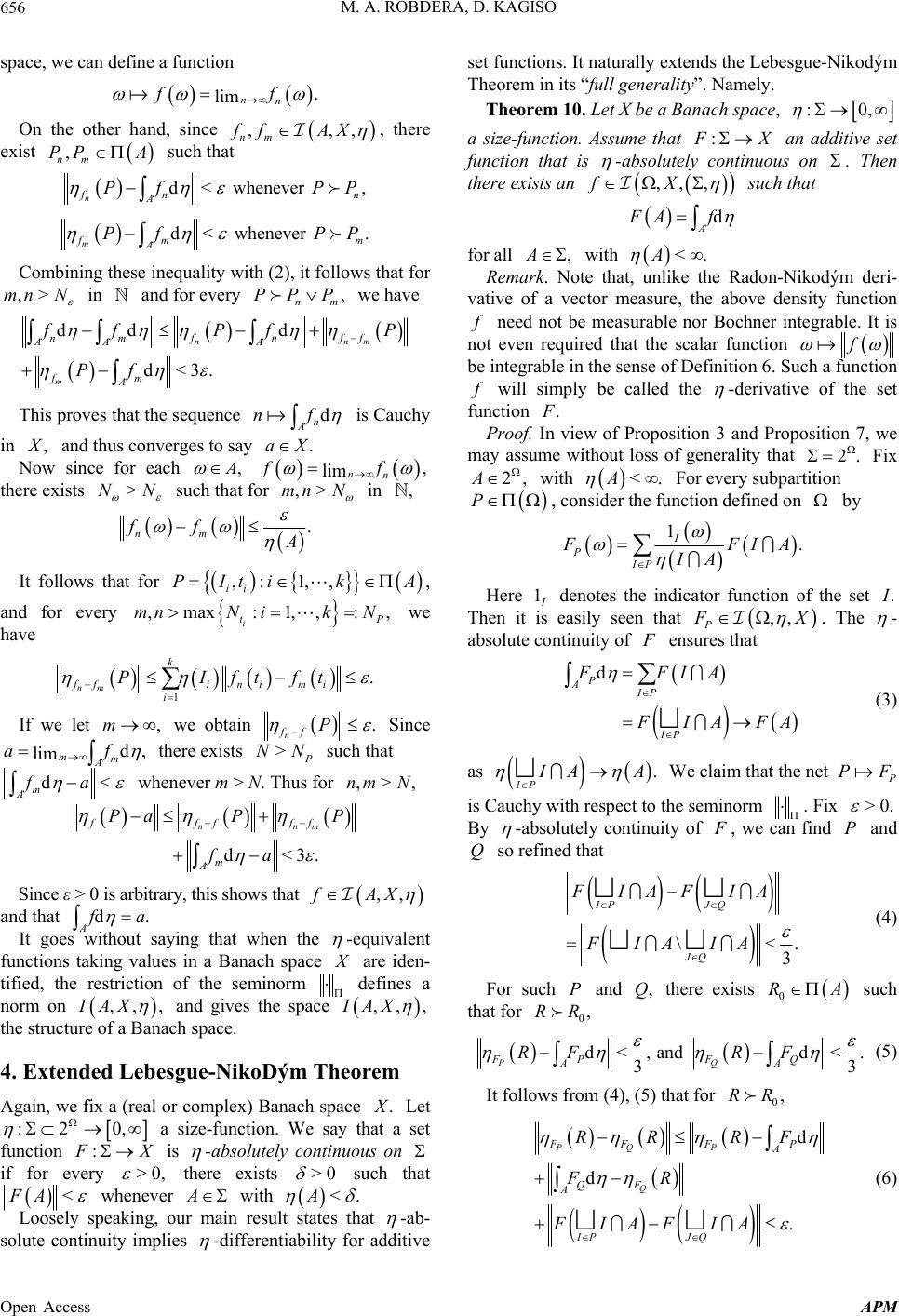 M. A. ROBDERA, D. KAGISO 656 space, we can define a function . limnn ff On the other hand, since ,, nm ff AX , , there exist such that , nm PP A d< whenever, n f n A Pf PP n d< whenever. m f mm A Pf PP Combining these inequality with (2), it follows that for ,>mnN in and for every we have , nm PPP dd d d<3. n m nm fnff AA A fm A nm f fPf Pf P This proves that the sequence d n A nf is Cauchy in , X and thus converges to say .aX Now since for each , A , limnn ff there exists >NN such that for ,>mnN in , . nm ff A It follows that for ,: 1,, ii P It ikA, and for every we have ,max:1,,: i t mnNikN, P 1 . nm k ffi nimi i PIftft If we let we obtain ,m . n ff P Since d,f limmm A a there exists > P NN such that d< m Afa whenever m > N. Thus for ,>,nm N d<3. nnm fffff m A Pa P fa P Since ε > 0 is arbitrary, this shows that ,,fAX and that d.fa A It goes without saying that when the -equivalent functions taking values in a Banach space X are iden- tified, the restriction of the seminorm defines a norm on ,, ,IAX and gives the space ,, ,IAX the structure of a Banach space. 4. Extended Lebesgue-NikoDým Theorem Again, we fix a (real or complex) Banach space . X Let :2 0, : a size-function. We say that a set function F X is -absolutely continuous on if for every >0, there exists >0 such that <FA whenever A with A<. Loosely speaking, our main result states that -ab- solute continuity implies -differentiability for additive set functions. It naturally extends the Lebesgue-Nikodým Theorem in its “full generality”. Namely. Theorem 10. Let X be a Banach space, :0, a size-function. Assume that : F X an additive set function that is -absolutels on y continuou . Then there exists an ,,,fX such that d A F Af ,A for all with <.A unlike thRema te that,erk. No Radon-Nikodým deri- vative of a vector measure, the above density function f need not be measurable nor Bochner integrable. It is t even required that the scalar function no f be integrable in the sense of Definition 6. Su f will simply be called the ch a function -derivative of the set ction . fun F Proof. In view of Proposition 3 and Proposition 7, we may assume without loss of generality that 2. Fix 2,A with <.A For every subpartition P , conunction defined on sider the f by 1I. P IP F FI A IA Here denotes the indicator function of the set . I 1 I Then it easily seen that ,, P is F X . The - absolute continuity of F ensures that dFFIA P AIP IP F IA FA (3) as . IP I AA We claim that the net P PF auchy with respect to tis Che seminorm . Fix >0. By F , we-absolutely continuity of can find P and Q so refined that \< 3. JQ JQ I FIAIA IP FIAF A (4) For such and there exists P ,Q 0 RA such that for 0,RR d<, d< 33 Q P FQ AA Fand . P F RF R (5) It follows from (4), (5) that for 0,RR d d . PQ P FF FP RR Q A QF A IP JQ RF FR FI AF IA (6) Open Access APM 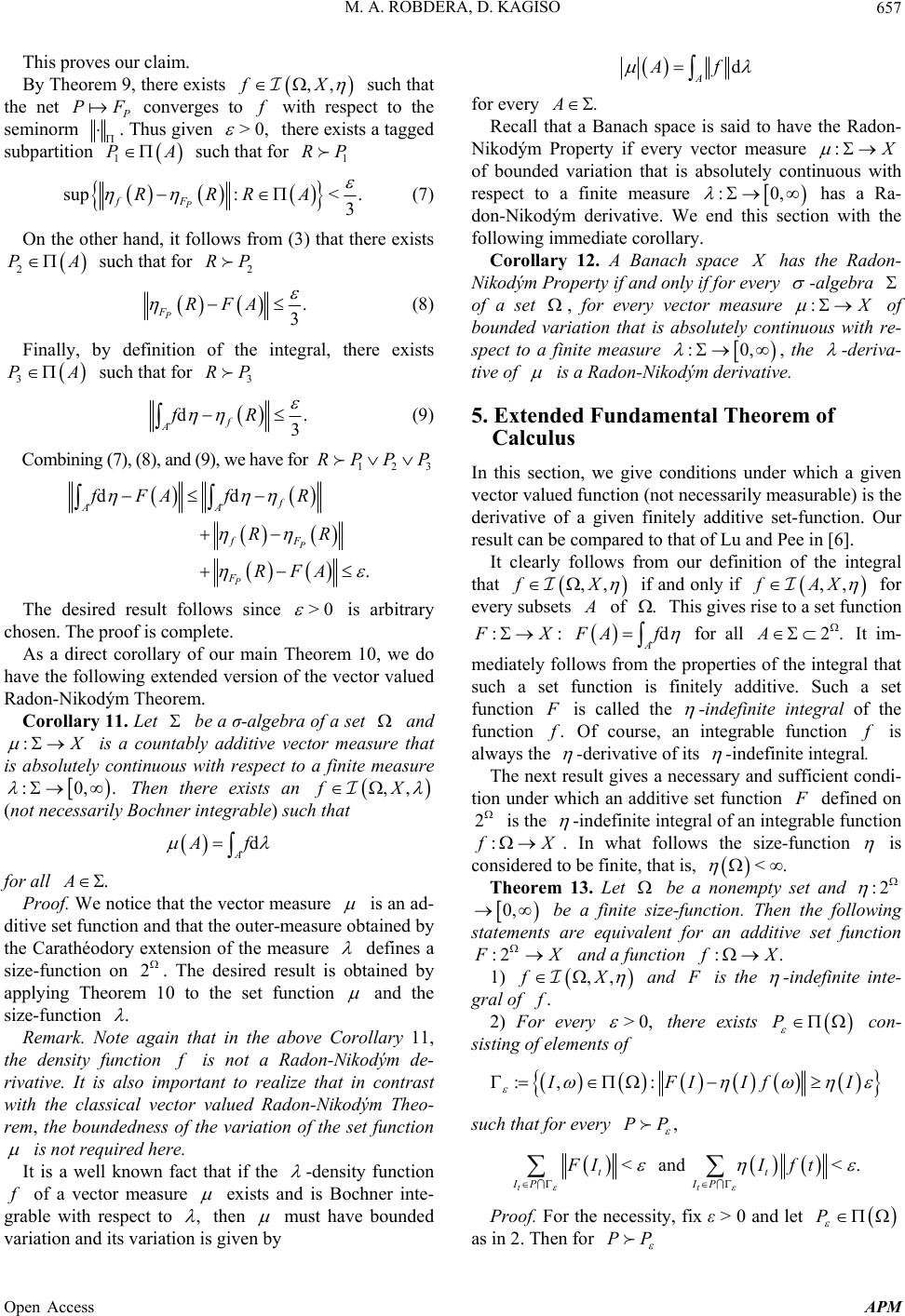 M. A. ROBDERA, D. KAGISO 657 This proves our claim. By Theorem 9, there exists ,,fX such that the net P PF converges seminorm to f with respect to the . Thus given >0, there exists a tagged that for 1 RP subpartition su PA 1ch sup P fF R:< . 3 RRA (7) other ho su On theand, it follows frm (3) that there exists 2 PA ch that for R 2 P . 3 P FRFA (8) Finally, by definition of the integral, there ex ists 3A such that for 3 RP P df. 3 f AR (9) Combining (7), (8), and (9), we have for3 12 RPPP dd f fFA fR . A P P AA fF F RR RF The desired result follows since >0 is arbitrary chosen. The proof is complete. As a direct corollary of our main Theorem 10, we do have the following extended version of the vectoued Radon-Nikodým Theorem. Corolla ry 11. Let be a σ-algebra of a set r val and : X is a countably additive vemeasure that is absolutely continuous with respect nite measure ctor to a fi :0,. Then there exists an ,,fX (not necessarily Bochner integrable) such that d A A f for all . Proof. We notice that the vector measure A is an ad- ion and that the outer-meas the Carathéodory extension of the measure ditive set functurtained bye ob de fines a size-function on. The desired ult isained by applying Theoo the set nction 2 rem 10 t res fu obt and the ction size-fun. Remark. Note again that in the above Collary 11, the density function or f is not a Radon-Nikodým de- rivative. It is also important to realize that in contrast with the classical vector valued Radon-Nikodým Theo- rem, the boundedness of the variation of the set function is not required here. It is a well known fact that if the -density function f of a vector measur dAf A for every .A Recall that a Banach spce is said to have the Radon- Nikodým Property if ey vecto measure : a ver r X of bounded variation that is absolutely cont respect to a finite measure don-Nikodým derivative. We llary. inuous with has a Ra- on with the :0, end th sectiis following immediate coro Corollary 12. A Banach space X has the Radon- Nikodým Property if and only if for every -algebra of a set , for every vector measure : X of bounded variation that is absolous with re- spect to a finite measure :0, , the utelontiy cnu -deriva- tive of is a Radon-Nikodým derivative. 5. Extended Fundamental Theorem of Calculus In this section, we give conditions under which a given vector valued function (noteasurale) is the derivati of a given finitely additive set-f necessarily mb veunction. Our integral th result can be compared to that of Lu and Pee in [6]. It clearly follows from our definition of the at ,,Xif and only if ,,fAX f e exists and is Bochner inte- grable with respect to , then must have bounded variation and its variation is given by for every subsets A of . This gives rise to a set function : F X : d A F Af for all 2.A It im- mediately follows from the properties of the integral that such a set function is finitely additive. Such a set function F is called the -indefinite integral of the funct . f Of coble function ion urse, an integra f is always the -derivative its of -indefinite integral. The next result gives a necessary and sufficient condi- tion under which an additivon e set functi F defined on 2 is the -indefinite integral of an integrable function : f X . In what follows the size-function is consideredo be finite, that is, t <. Theore13. Let m be a nonempty set and :2 0, b a finite size-functon. Then the following st e i atements are equivalent for an additive set function :2 F X and a function :. f X ) 1 ,,fX and F is the -indefinite inte- gral of . f 2) For every >0, there exists P con- sisting of elements of :, :IFIIfI every ,PPsuch that for <and<.FII ft tt tt IP IP ssity, fix ε > 0 and let Proof. For the nece P as in 2. Then for PP Open Access APM  M. A. ROBDERA, D. KAGISO 658 \ \ 2. t tt t ff ii ii IP tt IP IP t IP F t IP t ii IP PF P I ft FIIft IFI Ift Since FI FI I ft >0 is arbitrary, this shows that ,,fX and Conversely, assume that d.fF ,,fX . Let .k Given ε > 0 there exists a η-subpartition :1 k Ekf ,k P such that for every ,, k PP 2 1. 2 t tt k IP FIt k I f For each , n let if 0 n k 1 otherwise. k n f E f Then for , 1, n k k PP we have . 2 tt t tn t IP IP tt IP I ft Ik FII ft k On taking the limit as , we infer that n . 2 t t Ift IP It then follows that . 22 t IP f t tt ttt IP IP t FIFII ft I The proof is complete. Let now assume that is a topological space. We say that a size-function :2 of 0, . For a fi is regular if it is no sxed n-zero on open set, let the set of all neiω. Tghborhoods of hen ng e followiis directed by inclusionce th definition. Definition 14. Let We introdu . be a topological space and :2 0, a re size-function. Let gular2 contain the topology of . A set function : F X is said to be -differentiable at a point , if , m F exists in X . In other words, : F li X is -differentiable at a point , if there exists a vector f X such that for every >0, there exists open neighborhood ,U such that for every ,U ,U U <.UU fUF We call the set , : ts lim F F exis the domain of differentiability of . F By the uniqueness ofspondence net limit, the corre , lim F nc denoted by F defines a fution on F and called the -derivative of . F is compact. Let 2 Now assume that con- taining the topology of , and :2 F X an \,E addi- tive set function such that F with E 0. Given >0, let U be an open set such that EU and <U . On the other hanfor every ,d, F there exists an open neighbo rhood U ,,UUU such that for every <.FUU fU Clearly, :UU F . is an open cover of By compactness, a finite subcover exy ists, sa : . iiF UiU Let ,1,,n P ch that for su 1,, n. min ,: i PUUi Then the set P , and any arbitrar and 1. of Th 13 is satisfied by F y extension o eorem f F to . It follows th-function at since the size is und va hsion of boed riation, t is an element of en any such exten ,,, X and F is its -indefinite integral. Hene following result which can be seen as ce we have th a generalization of the Fundamental Theorem Cal- cu rem 15. Lact topological space, of lus. Theo et Ω be a comp 2 containing the topology of Ω and :2 0, additive set be a finite re fun gular size-function. Then every ction : F X omain of differentiability with d Open Access APM 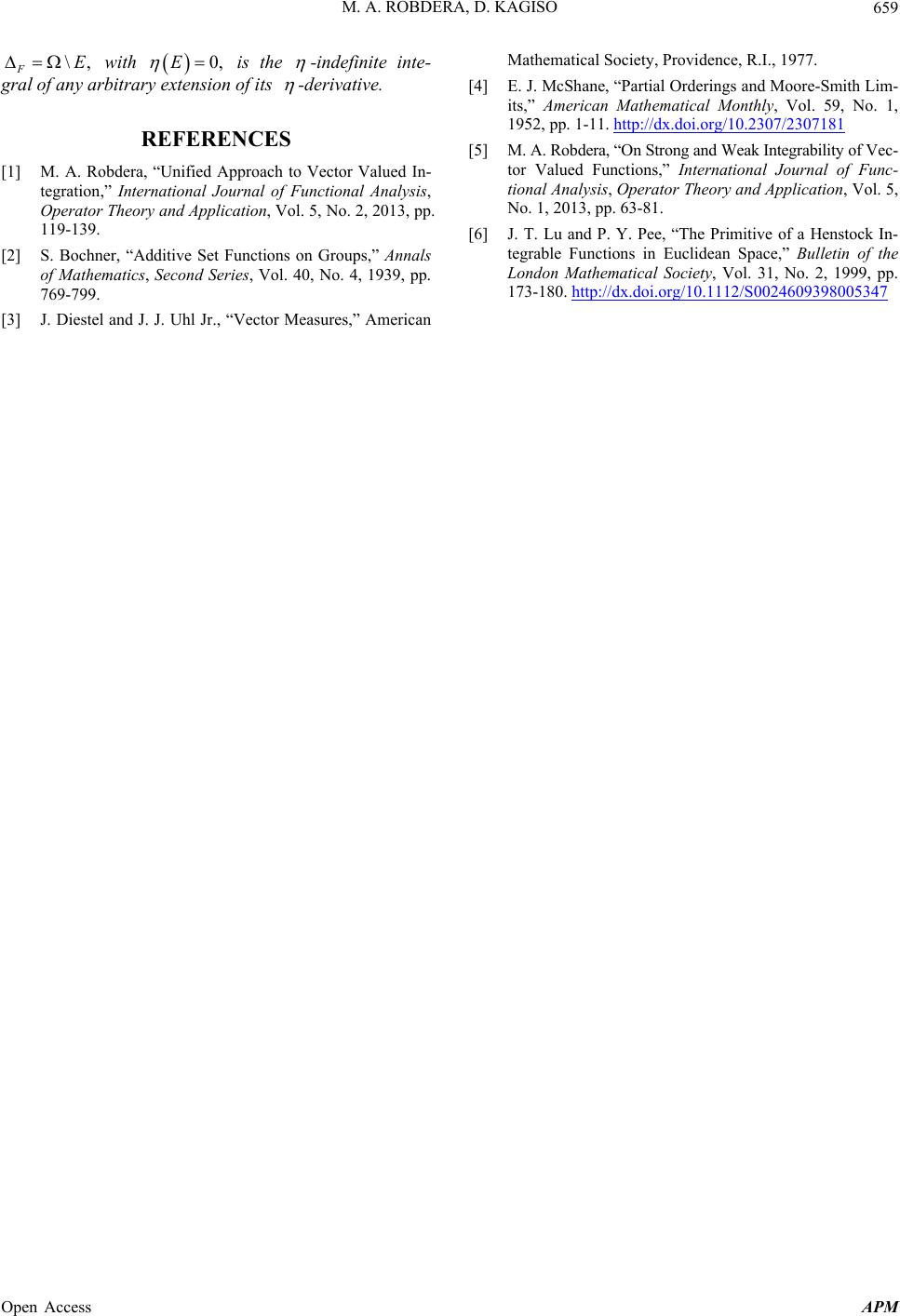 M. A. ROBDERA, D. KAGISO Open Access APM 659 \, FE with 0,E is the -indeite in- gral of any arbitrary extension of its fin te - erivative. REFERENCES [1] M. A. Robdera, “Unified Approach to Vector Valued In- te d Journal of Functional gration 799. ,” In Analysis ane, “Partial Orderings and Moore-Smith Lim- ternational Mathematical Society, Providence, R.I., 1977. [4] E. J. McSh its,” American Mathematical Monthly, Vol. 59, No. 1, 1952, pp. 1-11. http://dx.doi.org/10.2307/2307181 [5] M. A. Robdera, “On Strong and Weak Integrability of Vec- on, Vol. 5, the tor Valued Functions,” International Journal of Func- tional Analysis, Operator Theory and Applicati , No. 1, 2013, pp. 63-81. [6] J. T. Lu and P. Y. Pee, “The Primitive of a Henstock In- tegrable Functions in Euclidean Space,” Bulletin of Operator Theory and Application, Vol. 5, No. 2, 2013, pp. 119-139. [2] S. Bochner, “Additive Set Functions on Groups,” Annals of Mathematics, Second Series, Vol. 40, No. 4, 1939, pp. 769- [3] J. Diestel and J. J. Uhl Jr., “Vector Measures,” American London Mathematical Society, Vol. 31, No. 2, 1999, pp. 173-180. http://dx.doi.org/10.1112/S0024609398005347 |

